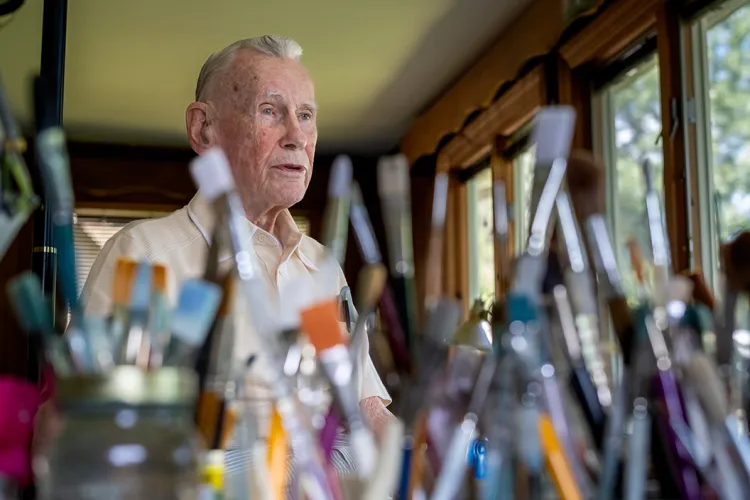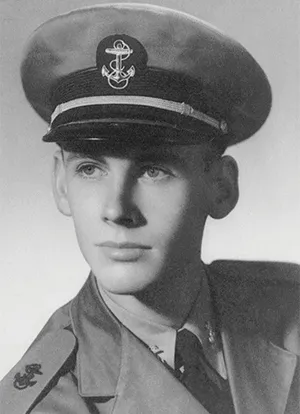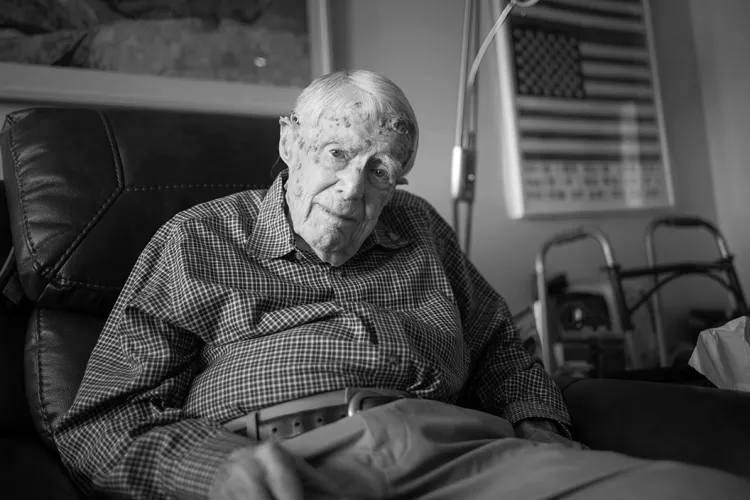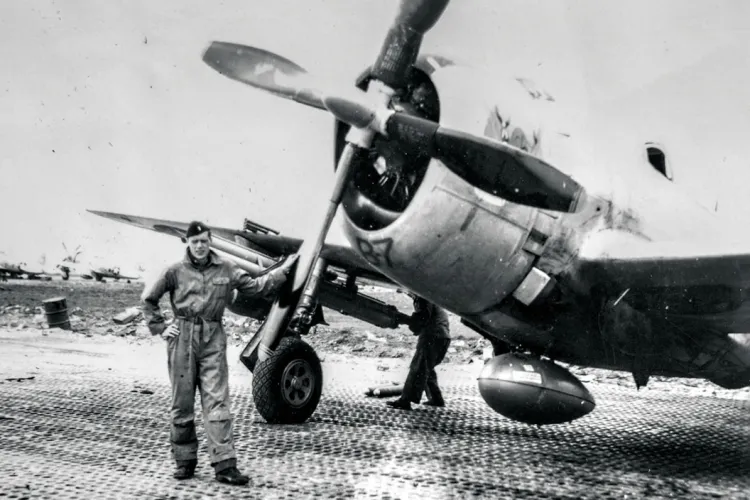Two Swarthmore Veterans Reflect on 100 Years of Life

Morton Huber, who recently turned 100, taught painting for many years on visits to England and became a fellow of the British Royal Society of Arts.
It's hard to picture military marches at Swarthmore. Or students studying gunnery and navigation. Swarthmore 80 years ago was both very different and much the same as it is today. Below, two Swarthmore centenarian alums share their life experiences, which were impacted by their military duty. The profiles are part of the A New Age from the Fall issue of the Bulletin alumni magazine.
Morton Huber arrived at Swarthmore in 1943 in a sailor’s uniform. He was 20 years old, part of the Navy’s first V-12 unit to arrive on campus. The V-12 program trained officers and engineers for World War II. For three years, Swarthmore was one of the hosts.
Huber had started college at Johns Hopkins University, but that quickly came to an end when the U.S. entered the war. He enlisted in the Navy. At Swarthmore, he took special courses in gunnery, navigation, and communication, as well as regular classes like chemistry and math. The sailors marched and drilled about campus, performed daily calisthenics, and lived together in one dorm.
He also had time to play lacrosse. Johns Hopkins was a leader in lacrosse, and “by the time I got to Swarthmore, I was pretty good with a stick,” he admits.
Indeed, he was Swarthmore’s high scorer. Swarthmore’s mixed civilian-sailor team beat Princeton and Penn State.
“We fielded a pretty good team,” says Huber fondly. “Our first game was West Point. Most of them had never seen a lacrosse stick.”
Like most V-12s, Huber’s stay at Swarthmore was short — just one year. He completed his naval training at Northwestern University and other sites before being stationed at Pearl Harbor in 1945. “I chose radar, so they sent me to radar school.”

At Swarthmore, Huber took special courses in gunnery, navigation, and communication, as well as regular classes like chemistry and math.
Science had long been a passion for Huber, and after the war, he became a biochemist. “I built a laboratory in my parents’ basement,” he says. “I stocked it with a fine microscope from an antique store.” He returned to Johns Hopkins to finish his degree and earned a Ph.D. from Cornell University Medical College.
While teaching chemistry at Emory and Henry College, Huber met Kyoko Ushio, a student sponsored by the U.S. armed forces in Japan. They married in 1962 at the U.S. Embassy in Tokyo. They lived in Japan for nine years. Huber was a professor of biochemistry and environmental science at the Kanazawa Institute of Technology in Kanazawa, Japan. He also pursued his growing interest in art.
“In my free time, I went out and worked with my cameras and my paintbrush,” he says.
He studied vanishing cultures of nearby mountain villages, including kamishibai, “paper theater” made of cardboard performed by itinerant storytellers who traveled by bicycle.
Back in the U.S., Huber changed course to art and built a studio in his home.
“I had a dual career,” he says. “I was sort of doing STEAM before it came along.”
After a 20-year career in biochemistry, Huber published five books about art and Japanese culture.
He taught painting for many years on visits to England and became a fellow of the British Royal Society of Arts. Stateside, he served as president of the Baltimore Watercolor Society. His wife Kyoko, a pianist, still teaches at High Point University in North Carolina. Huber’s watercolors and photography have been shown in galleries around Baltimore.
This July, Huber turned 100. He’s been happily married for 61 years and still paints in his home studio in North Carolina.
“Pick something as a career that’s really enjoyable, something you love to do,” he says. “Whatever you do, do something helpful to society. We need good people.”

John Wenzel ’47
John Wenzel ’47 began his college days as a happy-go-lucky freshman at Lafayette College. He joined a fraternity. He didn’t study much.
“Pearl Harbor changed all of that,” says Wenzel. “It interrupted a Sunday morning bridge game in my fraternity house.”
Soon after the Dec. 7, 1941, bombing of Pearl Harbor, Wenzel enlisted in the Aviation Cadet Program in the Army Air Corps. He was 19.
“I had never been near a plane and never owned a gun,” he says. He boarded a train from New York filled with new recruits and completed basic training in Miami Beach. Next came a series of flight schools.
“It was very competitive and I was starting from scratch,” he says. The training took 20 months.
After he earned his cadet wings, Wenzel completed six more months of flight training before heading to Pisa, Italy, to fly the P-47 Thunderbolt.
“It was exactly what I had hoped for. I didn’t want multi-engine planes; I wanted a fighter plane. I didn’t want to go to the Pacific; I wanted to fight the Nazis in Europe because they were the greater immediate threat to civilization.”
Wenzel didn’t talk about his war experiences when he returned home. He refers to the war and its aftermath as “the dark time.”
One thing he knew: He couldn’t go back to being a carefree college kid anymore. He switched schools, choosing Swarthmore because of its strong academic reputation. This time around, he focused on his studies and lived at home with his parents in Philadelphia.
Wenzel was born in Manhattan in 1923, one of four children, with a stay-at-home mother and a father who worked in automotive finance. The Depression shaped his early years.

After he earned his cadet wings, Wenzel completed six more months of flight training before heading to Pisa, Italy, to fly the P-47 Thunderbolt.
“We were the family handing out sandwiches, not asking for sandwiches,” he says. “However, I was at the right age to see it all, and to wonder why the long lines of unemployed couldn’t work in the empty factories.”
At Swarthmore, he majored in economics, but “had more credits in English literature.” He liked to paint. He loved jazz and golf. He kept the war buried and worked in finance, first at Chase Bank in Puerto Rico in the foreign credit department, then in New York for David Rockefeller. He joined the Ideal Corp., an automotive-parts manufacturing company in Brooklyn, and worked his way up to become its president. When Ideal was acquired by Parker Hannifin, he headed the automotive division.
Wenzel married in 1953. He and his wife Alice were married for 52 years until her death in 2005. They have two daughters, Emily and Abby, two granddaughters, and one great-granddaughter.
As his 100th birthday approached, Wenzel decided he finally wanted to make a statement about the war. He agreed to an interview with a New York Times reporter and, in an April 2023 feature, shared the story he’d never told.
Many readers reached out to him. He’s glad of that. “I don’t want the war to be forgotten,” he says.
He hopes younger people will recognize the tremendous sacrifices people made worldwide to defeat such a grave threat to civilization. On his 100th birthday, Wenzel’s family and friends toasted him with champagne. He no longer plays golf or travels, but he still loves jazz and art.
Life at 100? “It’s very difficult,” he says, “and special at the same time.”



